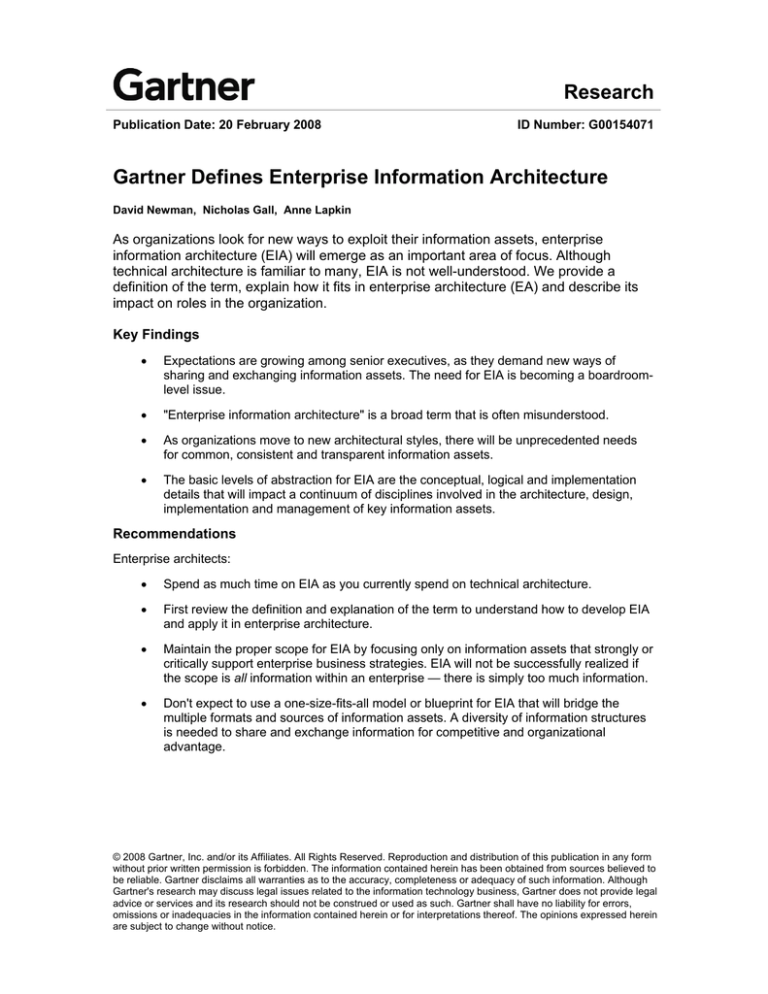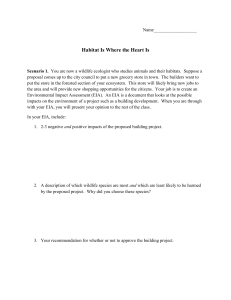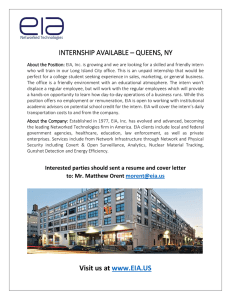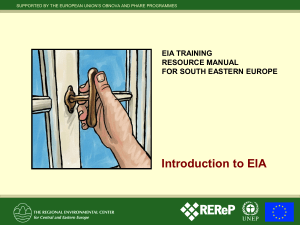
Research
Publication Date: 20 February 2008
ID Number: G00154071
Gartner Defines Enterprise Information Architecture
David Newman, Nicholas Gall, Anne Lapkin
As organizations look for new ways to exploit their information assets, enterprise
information architecture (EIA) will emerge as an important area of focus. Although
technical architecture is familiar to many, EIA is not well-understood. We provide a
definition of the term, explain how it fits in enterprise architecture (EA) and describe its
impact on roles in the organization.
Key Findings
•
Expectations are growing among senior executives, as they demand new ways of
sharing and exchanging information assets. The need for EIA is becoming a boardroomlevel issue.
•
"Enterprise information architecture" is a broad term that is often misunderstood.
•
As organizations move to new architectural styles, there will be unprecedented needs
for common, consistent and transparent information assets.
•
The basic levels of abstraction for EIA are the conceptual, logical and implementation
details that will impact a continuum of disciplines involved in the architecture, design,
implementation and management of key information assets.
Recommendations
Enterprise architects:
•
Spend as much time on EIA as you currently spend on technical architecture.
•
First review the definition and explanation of the term to understand how to develop EIA
and apply it in enterprise architecture.
•
Maintain the proper scope for EIA by focusing only on information assets that strongly or
critically support enterprise business strategies. EIA will not be successfully realized if
the scope is all information within an enterprise — there is simply too much information.
•
Don't expect to use a one-size-fits-all model or blueprint for EIA that will bridge the
multiple formats and sources of information assets. A diversity of information structures
is needed to share and exchange information for competitive and organizational
advantage.
© 2008 Gartner, Inc. and/or its Affiliates. All Rights Reserved. Reproduction and distribution of this publication in any form
without prior written permission is forbidden. The information contained herein has been obtained from sources believed to
be reliable. Gartner disclaims all warranties as to the accuracy, completeness or adequacy of such information. Although
Gartner's research may discuss legal issues related to the information technology business, Gartner does not provide legal
advice or services and its research should not be construed or used as such. Gartner shall have no liability for errors,
omissions or inadequacies in the information contained herein or for interpretations thereof. The opinions expressed herein
are subject to change without notice.
STRATEGIC PLANNING ASSUMPTIONS
•
The need to deliver increased business value from information assets will force 60% of
Global 2000 organizations to establish an executive sponsor for enterprise information
architecture.
•
By 2010, 70% of EA teams will be forced by the business to spend as much time on
information architecture as they currently spend on technical architecture.
ANALYSIS
Background
Gartner sees EIA as an area of increased importance to the enterprise — this is from the need to
maximize the value and effectiveness of information assets, while limiting the impact of
widespread, unmanageable information sources.
Today's business strategies call for organizations to be more globally interconnected and enduser-driven. Organizations must also cope with increased scrutiny from compliance or regulatory
mandates, which place greater demands on the transparency and accountability of information
across their operations. In addition, business process improvement initiatives are exacerbating
the need to migrate from legacy data structures to more-agile data services and authoritative
information sources that support the rapid assembly of business services and new solutions.
These converging trends are forcing organizations to rethink how they can best architect and
manage information for competitive and organizational advantage. Enterprise information
architecture fills these needs and brings structure to information chaos.
The need for EIA has become a boardroom-level issue. Expectations are growing among senior
executives who believe that information assets should be exploited for strategic advantage. The
2007 Gartner and Forbes survey showed that the top priority among executives was the use of
information as a competitive weapon (see "The Gartner/Forbes Executive Survey"). The need to
deliver increased business value from information assets will force 60% of Global 2000
organizations to establish an executive sponsor for enterprise information architecture.
Information cannot be used as a weapon unless a plan and architecture are in place to exploit
and manage it. EIA, as a component of enterprise architecture, provides the plan to enable
organizations achieve business strategies by flexibly sharing and exchanging information assets
for advantage. Without EIA, information will remain a liability and a barrier to success: It will
continue to add cost (for example, increased demands for storage), complexity (for example, silos
complicating system integration) and risk (for example, compliance, transparency or legal issues)
to the enterprise.
To understand EIA more fully, practitioners should understand the definition and explanation of
the term.
A Definition of EIA
Gartner defines "enterprise information architecture" as that part of the enterprise architecture
process that describes — through a set of requirements, principles and models — the current
state, future state, and guidance necessary to flexibly share and exchange information assets to
achieve effective enterprise change.
Publication Date: 20 February 2008/ID Number: G00154071
© 2008 Gartner, Inc. and/or its Affiliates. All Rights Reserved.
Page 2 of 6
By examining the components of the definition, practitioners will get a sense of how to create and
apply EIA, and how it can be used to bridge strategy and implementation.
A Detailed Explanation of the EIA Definition
First, we state that "enterprise information architecture is that part of the enterprise
architecture process." EIA is one of the three primary viewpoints in enterprise architecture
(along with the enterprise business architecture and enterprise technical architecture).
Each viewpoint includes multiple levels of abstraction and specificity. The minimum levels of
abstraction for EIA are conceptual, logical and implementation, which impact the continuum of
disciplines involved in the architecture, design, implementation and management of key
information assets, as well as dependencies to other disciplines.
Second, we add "describes — through a series of requirements, principles and models."
This is to identify the types of EIA deliverables.
Driven by the goals and objectives of the business strategy, EIA requirements generally state
how specific information will flow among groups inside and outside the enterprise, and the
integration guidelines between customers, partners or suppliers. Similarly, additional
requirements govern the quality, timeliness, security and accessibility of key information assets.
A common EIA principle among clients today is the guideline to "establish a single version of
customer data across the organization." This would then drive evaluations by various teams on
master data management patterns or implementation styles (see "Information Architecture
Patterns Provide Valuable Guidance").
Sample EIA models often include the development of shared data models to achieve consistency
or reuse objectives or project jump-starts. Models would also include business process and
information requirements from a conceptual level of detail through the logical design of services
and components. These models would then influence roles such as service, component or
application designers; integration specialists; and workflow managers on the physical
implementation aspects of the EIA.
Third, the words "current state, future state and guidance" address how and when EIA
deliverables are implemented across the enterprise, as outlined in the enterprise architecture gap
plan and road map.
Today, many organizations are embracing business strategies that require agile business
processes, and they are trying to move away from isolated systems and organization silos. To
satisfy such needs, these enterprises are migrating from traditional client/server architecture
styles to other architectural styles (such as service-, Web- or context-oriented delivery). Such
styles will require a greater level of commonality, consistency and transparency of information
assets (see "Key Issues for Application and Application Architecture Management, 2007").
Fourth, the words "flexibly sharing and exchanging information assets" present particular
challenges because of the breadth and magnitude of available options.
At the outset, though, it is important to clarify that information assets be defined as those assets
expressed in some digitized structure (as distinguished from knowledge management, which
addresses knowledge or information in tacit or unexpressed forms).
A key challenge to EIA is that digitized information exists in multiple and inconsistent formats and
structures (ranging from structured to semistructured to unstructured information assets), which
limits the ability to access, share and exchange information. Architects need to recognize that
there is no one-size-fits-all blueprint or model that will resolve all semantic differences.
Publication Date: 20 February 2008/ID Number: G00154071
© 2008 Gartner, Inc. and/or its Affiliates. All Rights Reserved.
Page 3 of 6
Different and diverse structures for exploiting information assets will continue to be used in the
near future. Databases, transaction systems or analytical applications remain particularly effective
for exploiting large volumes of information from business transactions. Data models, process
models, object models and other design patterns will be used by architects, designers and
implementers to exploit information. Other structures (such as document management systems,
content management systems or other formats) are equally effective and will require the
development of taxonomies, topic maps and ontologies to maximize the value and shareability of
information contained therein. In addition, converged content in the form of mashups and portals
represent new methods of information organization and exploitation. Finally, the increasing use of
XML for data exchange and canonical models to improve information integration rounds out the
broad array of possibilities within enterprise information architecture.
It is not feasible for EIA to define all the myriad information structures to be used in the enterprise.
Most of these structures are effectively outside EIA's influence — often because they are under
the control of a commercial off-the-shelf (COTS) vendor. Instead, the enterprise information
architecture should focus on integrating, sharing and reconciling such disparate information
"views." This is similar to the scope of enterprise technology architecture, which is primarily
focused on integrating technologies through the use of patterns. The primary scope of EIA, then,
is on sharing information to enhance flexibility.
Finally, the words "and achieve effective enterprise change" help architects maintain scope
against the growing glut of information and to focus solely on information assets required for
successful business strategy execution.
A common misconception is that the scope of enterprise information architecture is all information
in the enterprise. Although true at an abstract level, in reality, the focus of EIA is on information
assets that are deemed to have enterprise significance and that are necessary to achieve
effective business change.
Master data for products or customers is an example of enterprise information assets. These
assets support the enterprise business strategy for consistent product or customer information
and a "single version of the truth." This scoping distinction lets architects avoid trying to architect
all information in the enterprise, or the "boiling the ocean" syndrome.
Clearly, not all information has the same value. Neither does all information support strategic
business goals and the change agenda. By maintaining this scope, practitioners can cut through
the information glut and concentrate on the information assets that are most valuable to the
organization as a whole.
Although EIA contributes to enterprise change, it is not sufficient by itself. Equally important are
the skills of business users who use information to drive change by making better, more-informed
decisions or who manage or monitor corporate performance. These individuals look to combine
information in new and unexpected ways to uncover new relationships, insights, trends and
patterns that will yield additional business opportunities.
EIA's Impact on Roles
The transition from information that is isolated within applications to a flexible, comprehensive
enterprise information architecture will require changes in technology, process, organizational
structure and orientation. In particular, EA practitioners comfortable with technical architecture
must now devote time to understanding this emerging discipline. Gartner projects that, by 2010,
70% of EA teams will be forced by the business to spend as much time on information
architecture as they currently spend on technical architecture.
Publication Date: 20 February 2008/ID Number: G00154071
© 2008 Gartner, Inc. and/or its Affiliates. All Rights Reserved.
Page 4 of 6
Changes will also impact a range of disciplines across the organization and will require
coordination to drive efficiencies and achieve objectives (see "Putting Enterprise Information
Management in Context").
Roles that will participate in the organization's desire to maximize the value and effectiveness of
information assets include:
•
Architects (including solution architects)
•
Application designers
•
Data modelers
•
Database administrators
•
Business intelligence specialists
•
Master data management specialists
•
Data quality specialists
•
Data integration specialists
•
Metadata management specialists
•
Business analysts
•
Content management specialists
•
Professionals in security, compliance, privacy and related disciplines
Some of these roles will be done concurrently, depending on the size of the teams, the rules of
engagement (that is, "who does what at which point in the activity cycle"), the depth of domain
knowledge, and resource availability. Understanding the different roles impacted by EIA is a
critical first step.
The role of enterprise architects is to act as facilitator, planner, change agent, champion and
coach during these activities (but never dictator). Their job is to advocate the adoption and
assurance of all enterprise architecture deliverables. Enterprise architects should be wellequipped to handle this challenge, because of their strong relationships with the business and
their strategic planning skills. However, some will need to retool their skills. Those who step in,
and step up, to develop an EIA will help their organizations deliver new enterprise capabilities.
Conclusion
Pressure is growing on organizations to exploit information as a strategic asset. CEOs are
demanding action, and CIOs see it as a top priority. Gartner is predicting that enterprise
information architecture will be an area of increasing focus and influence. However, EIA remains
a broad and complex topic. As a start, EA practitioners should review the definition and
explanation of the term provided here to understand its role and value in enterprise architecture.
RECOMMENDED READING
"Information Architecture Patterns Provide Valuable Guidance"
"Key Issues for Information and Application Architectures Management, 2007"
Publication Date: 20 February 2008/ID Number: G00154071
© 2008 Gartner, Inc. and/or its Affiliates. All Rights Reserved.
Page 5 of 6
"Predicts 2008: Emerging Trends Force a Clearer and Deeper Focus on Enterprise Architecture"
"Putting Enterprise Information Management in Context"
"The Gartner/Forbes Executive Survey"
REGIONAL HEADQUARTERS
Corporate Headquarters
56 Top Gallant Road
Stamford, CT 06902-7700
U.S.A.
+1 203 964 0096
European Headquarters
Tamesis
The Glanty
Egham
Surrey, TW20 9AW
UNITED KINGDOM
+44 1784 431611
Asia/Pacific Headquarters
Gartner Australasia Pty. Ltd.
Level 9, 141 Walker Street
North Sydney
New South Wales 2060
AUSTRALIA
+61 2 9459 4600
Japan Headquarters
Gartner Japan Ltd.
Aobadai Hills, 6F
7-7, Aobadai, 4-chome
Meguro-ku, Tokyo 153-0042
JAPAN
+81 3 3481 3670
Latin America Headquarters
Gartner do Brazil
Av. das Nações Unidas, 12551
9° andar—World Trade Center
04578-903—São Paulo SP
BRAZIL
+55 11 3443 1509
Publication Date: 20 February 2008/ID Number: G00154071
© 2008 Gartner, Inc. and/or its Affiliates. All Rights Reserved.
Page 6 of 6




